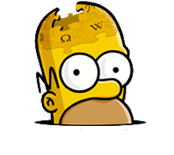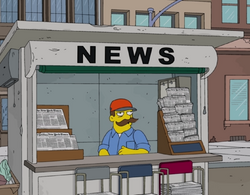
'The New York Times'
Warning: Display title "'<b>The New York Times'</b>" overrides earlier display title "<i>The New York Times</i>".
The New York Times
| |
| Newspaper Information
|
The New York Times is a newspaper which is published in New York City.
History
When Homer moved in with Grady and Julio, he saw Julio reading The New York Times over breakfast and asked him why he was reading it, as he was not living in New York. Julio answered that he read the Times because the headlines in The Springfield Shopper were all jokes. To prove his point, Julio showed Homer an issue of the Shopper.[1]
After Bart mooned the flag and the media started covering the incident, a newspaper editor told a reporter that he wanted to over-hype the story so much it would make the New York Post look like The New York Times. The editor then backed off and said "or The New York Times look like the New York Post", as he had forgotten which of the two papers was "the good one".[2]
When Professor Frink tried to get past The New York Times' firewall his house exploded and he flew out of it.[3]
Kent Brockman asked a newspaper vendor if he sold The New York Times. The vendor then replied "Sir, we are The New York Times!"[4]
Behind the Laughter
The New York Post and The New York Times are both real newspapers published in New York City. The editor's order to his reporter in "Bart-Mangled Banner" refers to the Post having a reputation for printing sensationalistic tabloid-style headlines, while the emphasis of the Times is on quality mainstream news coverage.
Appearances
 Episode – "Three Gays of the Condo" (mentioned)
Episode – "Three Gays of the Condo" (mentioned) Episode – "Bart-Mangled Banner" (mentioned)
Episode – "Bart-Mangled Banner" (mentioned) Episode – "How I Wet Your Mother" (mentioned)
Episode – "How I Wet Your Mother" (mentioned) Episode – "Four Regrettings and a Funeral"
Episode – "Four Regrettings and a Funeral"
References

